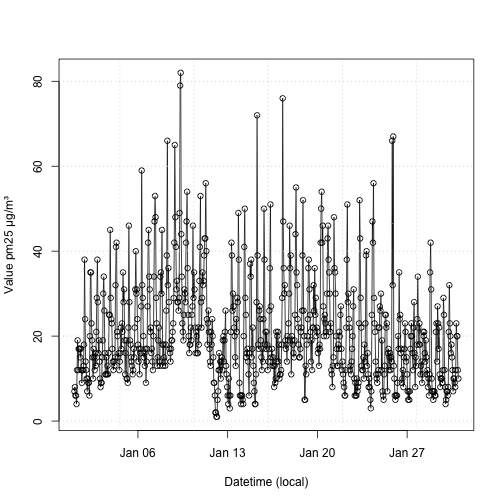Introduction
This vignette demonstrates how to use the openaq R package to query air quality measurements from the OpenAQ API. We will walk through the process of retrieving a list of locations, inspecting their sensors and parameters, and finally, fetching and plotting the actual measurements for a specific sensor.
Listing Locations
The list_locations() function allows us to retrieve
information about monitoring locations. We can filter locations based on
parameters and countries. Here, we are searching for locations that
measure PM2.5 (parameter ID 2) in Madagascar (country ID
182). By default resource functions return a data frame but we set
as_data_frame = FALSE to receive the data as a list, which
we will use for easier inspection in the following steps.
locations <- list_locations(
parameters_id = 2,
countries_id = 182,
as_data_frame = FALSE
)The locations object is a list, where each element represents a monitoring location. Let’s examine the first location in the list and explore its sensors.
location <- locations[[1]]
sensors <- location$sensors
sensors
#> [[1]]
#> [[1]]$id
#> [1] 225221
#>
#> [[1]]$name
#> [1] "pm25 µg/m³"
#>
#> [[1]]$parameter
#> [[1]]$parameter$id
#> [1] 2
#>
#> [[1]]$parameter$name
#> [1] "pm25"
#>
#> [[1]]$parameter$units
#> [1] "µg/m³"
#>
#> [[1]]$parameter$displayName
#> [1] "PM2.5"Each location contains information about its sensors. Each sensor has an id, name, and details about the measured parameter, including its name, units, and ID.
Each location also provides the timezone of where it is local, which will be helpful when querying measurements, so we will store this for later.
tz <- location$timezone
tz
#> [1] "Indian/Antananarivo"To fetch measurements, we need the sensor ID. This location only measures PM2.5 and in turn only has one sensor so we can extract it as follows:
sensors_id <- sensors[[1]]$id
sensors_id
#> [1] 225221Fetching Measurements
Now we can use the list_sensor_measurements() function
to retrieve the measurements for the sensor. We need to provide the
sensors_id, datetime_from, and
datetime_to arguments. We will query for all measurements
during the month of January 2025. It is important to use the correct
timezone for your dates, we use the timezone for location that we stored
in the tz variable above. The limit argument controls the
maximum number of measurements returned in a single page of results.
Because this is hourly data, and we are querying 31 days of
measurements, we will be able to view all the results in one page (24
hourly measurements * 31 days = 744 measurements).
measurements <- list_sensor_measurements(
sensors_id,
datetime_from = as.POSIXct("2025-01-01", tz = tz),
datetime_to = as.POSIXct("2025-01-31", tz = tz),
limit = 1000
)Finally, we can visualize the measurements using the
plot() function. openaq provide built-in
helpers for the base::plot function, read more in the
plotting vignette.
plot(measurements)
